
Drinking Vinegar: A Dandelion and Strawberry Shrub Recipe
I’ve been falling in love with shrubs, switchels, and all sorts of other interesting herbal infusions lately.
I’ve known about these vinegar-based drinks for years, but they always sounded a bit strange to me. Sure, I love vinegar as much as the next person, but drinking vinegar as a beverage? Is that something someone would really choose to do? Could it possibly taste good?
Thanks to Emily Han, author of Wild Drinks and Cocktails, I have been re-inspired to try these old-fashioned drinks. In her book, Emily (who’s also the Communications Director for LearningHerbs) writes that shrubs are a sour and tangy drink that were a common way to preserve the fruits of the harvest. She also says they “…became particularly popular during the Temperance movement because they were nonalcoholic yet zippy and refreshing.”
If drinking vinegar doesn’t sound so great to you, don’t worry. You don’t drink shrubs at full strength. Instead, they are a concentrated vinegared syrup that is used as a mixer in water, sparkling water, soda, or even cocktails.
I recently made a shrub recipe inspired by fresh springtime ingredients. Several days later my husband and I were out in the warm sunshine playing badminton when we both called “break.” (For the record, we don’t keep score, but I was pretty sure I was winning – I always am.) We were both parched and I immediately thought of my shrub experiment. I headed to the kitchen where I mixed the shrub into sparkling water and we sat down to enjoy our drinks and cool down. The drink was tangy and immediately refreshing. In fact, I was so impressed, I knew I had to share it with you.
Before we get to the shrub recipe, here’s a look at some of the benefits of the ingredients.
Benefits of Dandelion Roots
Dandelion roots are tenacious. If you harvest only a part of the root, the plant will heal itself and keep on growing! This fortitude is the bane of lawn lovers and a generous gift for those of us who adore dandelions.
Herbalists love dandelions as both a food and as medicine. Dandelions send their long roots deep into the earth, pulling vitamins and minerals into the plant. Fresh dandelion roots have a sweet and slightly bitter taste and they make a wonderful nutrient-dense food.
Herbalists also commonly use dandelion roots to support liver health. Because it improves liver function, dandelion root has rippling benefits for many symptoms associated with poor liver health, including acne, boils, and premenstrual syndrome (PMS).
There are many health benefits to all parts of the dandelion plant. If you’d like to explore dandelion more, check out our full-length monograph on HerbMentor.com.
How to Identify Dandelions
Being that dandelion is a common weed that practically everyone recognizes, it may seem strange to include a section on identification, but there are some similar lookalikes. In case you are new to harvesting dandelions, here are some simple tips for making sure you’ve got the right plant.
Leaves: The leaves grow in a basal rosette and are smooth, lacking any significant hairs. (Many dandelion lookalikes have downy leaves or little prickles along the major vein on the underside of the leaf.) The leaves are simple, with jagged edges, and are commonly referred to as the “teeth of a lion.” The “teeth” on the leaves point back toward the center of the rosette.
Flowers: The bright yellow flowers grow on a single leafless stem. (There are many dandelion lookalikes that have numerous yellow flowers on a single stem.) The flowers are a rich yellow color, as compared to the lighter yellow or darker orange of many lookalikes.
Roots: You’ll be harvesting the roots, which grow as a single taproot, similar to a carrot. The roots are light brown or tan in color.
Distribution: Although dandelions occur in every state of the US, they are much less common in the southern tier of the country, where they do not readily tolerate the heat.
If you still aren’t sure if the plants around you are dandelions, find someone who can expertly identify the plant. You should always be 100% certain of the identification of the plant before you eat it or make a shrub or medicinal preparation with it.
How to Harvest Dandelion Roots
Dandelions are small herbaceous perennial plants that grow in disturbed soils of temperate climate zones – from lawns to gardens to farms to roadsides to abandoned lots. It’s not uncommon to see dandelions growing through cracks in roads and sidewalks. When harvesting dandelion roots for eating, be sure to harvest in an area that has not been sprayed with herbicides or insecticides. Harvest away from areas that are likely contaminated with pollutants, such as roadsides.
Look for dandelions with a good clump of leaves. Dandelions with just a few leaves are very young and will only have a small root.
When using dandelion roots for medicine, I prefer to harvest them in the fall. However, dandelion roots are fine to use any time of the year and still offer many benefits.
I like to harvest the roots by using a digging stick. I dig around the outermost edges of the leaves to loosen the soil. In this way I avoid cutting into the root. Once the soil is sufficiently loosened, I reach down with my hands to gently further break up the soil and free up the root. If the root is still firmly attached to the soil and you pull too firmly, the root will easily break. In this case, it’s not all bad news since the roots will heal and keep on growing; however, it will significantly increase your harvesting time to dig twice as many roots!
If the leaves of the roots you are harvesting are young, you can add them to your salads or use them in a pesto.
You’ll want to wash your roots before using them in this shrub recipe. My favorite way to do this is to submerge them in a bowl of water and agitate the water. This helps to remove the biggest clumps of dirt. The roots can then be rinsed under running water to remove any last vestiges of dirt.
Benefits of Strawberries
Strawberries are especially savored as they are often the first ripe fruits of the growing season to appear at farmer’s markets and grocery stores. These berries are known for their vitamin C content and their high levels of antioxidants.
Strawberries are also the most heavily sprayed fruit on the market, earning them the distinction of being at the very top of the Environmental Working Group’s Dirty Dozen™ list of produce with the highest pesticide loads. Many of the pesticides used in the cultivation of strawberries have been shown to disrupt hormones and be associated with cancer, and many of these pesticides that are being used in the US are already banned in Europe.1 The Environmental Working Group reported that 2014 USDA tests on strawberries found:
- Almost all samples – 98 percent – had detectable residues of at least one pesticide.
- Some 40 percent had residues of 10 or more pesticides.
- The dirtiest strawberry sample had residues of 17 different pesticides.
- Strawberry growers used 60 different pesticides in various combinations.2
With this in mind, I believe it’s imperative to only buy organic strawberries or to harvest wild strawberries for this shrub recipe.
Benefits of Vinegar
While vinegar certainly has many health properties, it provides us with three very specific benefits in this shrub recipe.
- Shrubs are essentially a vinegar infused with fruits and sugar (or honey). The acidic qualities of the vinegar help to preserve the mixture. Shrubs are a great way to preserve an abundance of seasonal fruits.
- Besides preserving, vinegar is also wonderful an extracting minerals. For this recipe both the strawberries and the dandelion roots have beneficial minerals such as manganese, iron, carotenes, calcium, and potassium.
- And lastly, by drinking vinegar-based drinks, we are also benefiting from the sour taste. It might be strange to claim a taste has benefits, but the flavor of an herbal preparation is an important part of the actions attributed to that preparation. For example, the bitter taste is often heralded as an important taste for healthy digestion. Likewise, the sour taste also helps to stimulate the digestive process by stimulating the salivary glands. In this recipe, the sour taste also is cooling and refreshing, helping to quench thirst. (Lemonade is another great example of this flavor quality.)
Benefits of Honey
Honey is the main sweetener that we use in our home. I love that honey is an entirely local product that is more healthy and complex than standard cane sugar. Not only is honey better for our bodies, it’s also better for the environment.
My good friend is a beekeeper who is passionate about bees. She is constantly learning ways to grow stronger hives that are naturally resistant to pests and she speaks out locally against pesticides that are harmful to bees. By supporting my friend Susie and her work, I am also helping to support healthy bee populations.
Dandelion and Strawberry Shrub Recipe
This springtime shrub is a tangy and refreshing vinegared syrup with the aromatics of strawberries and the mineral-rich qualities of the dandelion root. Mix this shrub into a drink to quench your thirst on a hot day, or simply to enjoy the bounty and gifts of spring. This recipe was inspired by the shrub recipes in Emily Han’s book, Wild Drinks and Cocktails.
Many of the shrub recipes I previewed called for a couple cups of sugar. I’ve chosen to use honey to sweeten this recipe and I’ve also chosen to use significantly less of it. If you have a sweet tooth, you may prefer to add more honey to this shrub recipe.
What you’ll need…
- 2 cups strawberries (fresh or frozen)
- 1/2 cup fresh dandelion roots, chopped (or 1/4 cup dried dandelion roots)
- 2 tablespoons fresh ginger, minced
- 1 cup balsamic vinegar
- 1 cup apple cider vinegar (or white wine vinegar)
- 1/2 cup honey (or more to taste)
Chop the strawberries. Add them to a sterilized quart jar. Using a wooden mallet or spoon, slightly crush the strawberries.
Add the dandelion roots and ginger to the jar.
Add the vinegars and honey. Stir well.
Cover with a non-reactive lid: plastic, glass, or a piece of parchment or waxed paper in between the metal lid and the shrub. (Vinegar will corrode a metal canning jar lid and destroy the drink.)
Let this infuse for a week in the fridge. Shake it gently every day. Strain when done.
To serve your shrub:
Add 1-2 tablespoons of the shrub to 8 ounces of water, sparkling water, soda, or a cocktail. The drink should taste sour and sweet, with the aromatics of strawberries and a subtle zing of ginger.
Store the shrub in the refrigerator in a jar with a non-reactive lid. It should last for 6 months.
Yield: 2.5 cups



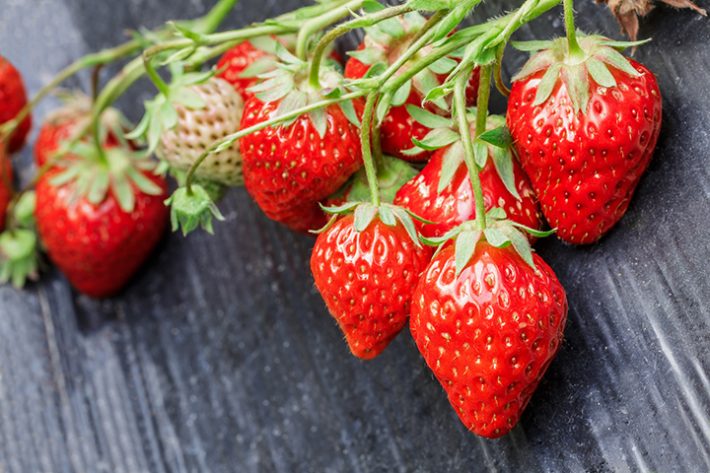

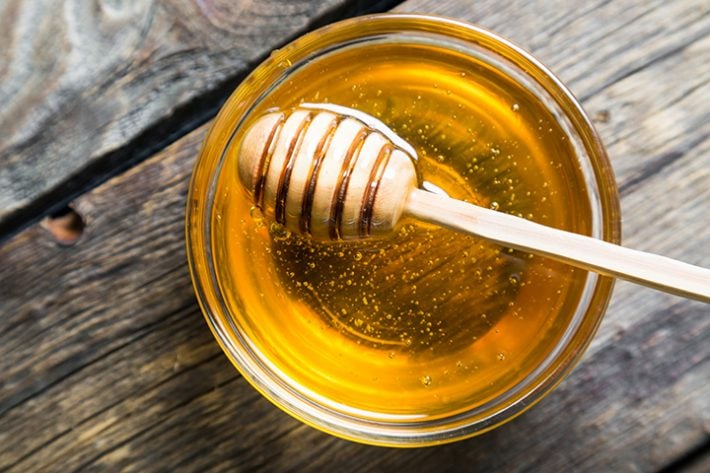
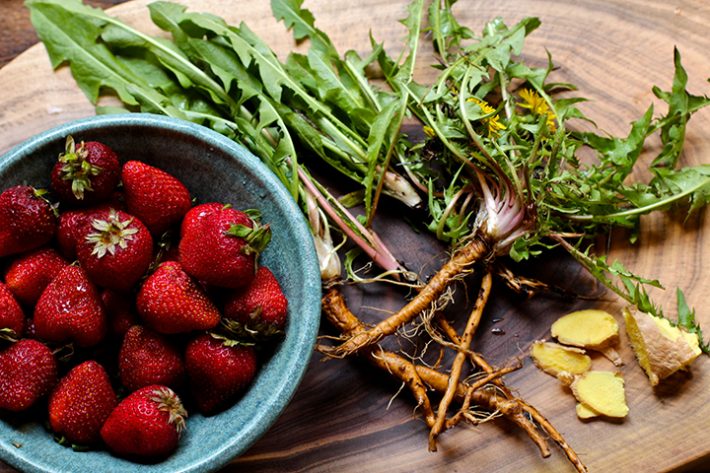
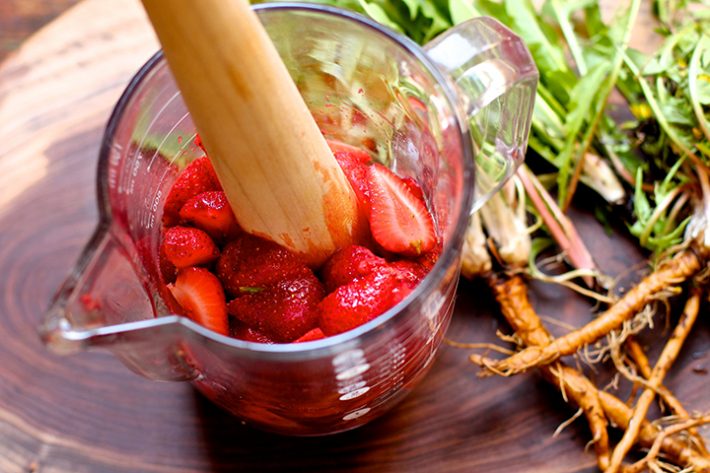
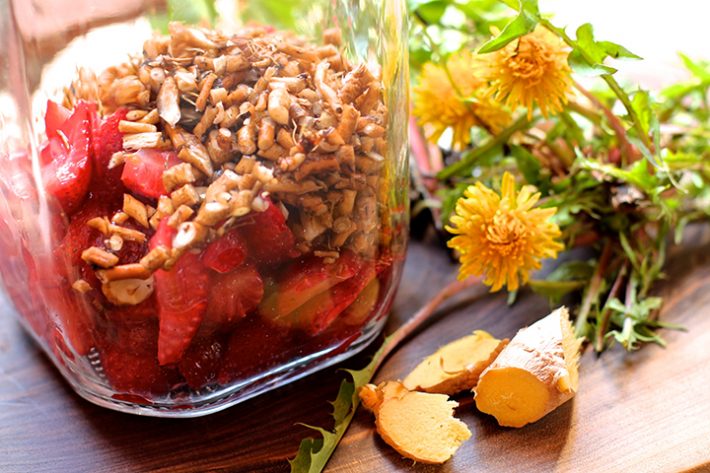
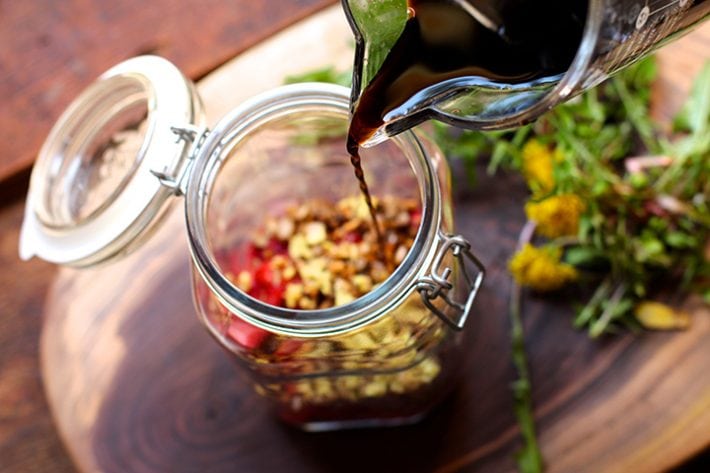

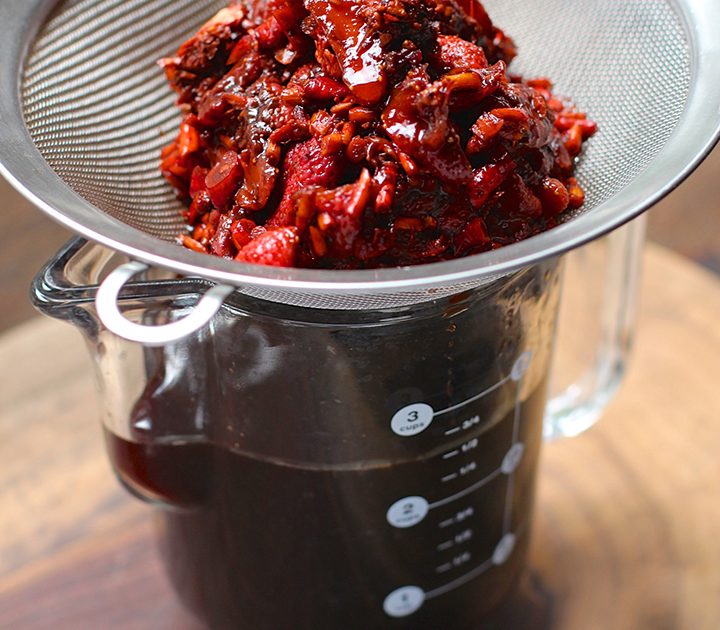








Don’t forget to download the PDF recipe card above. :-)
Hello! I make water and milk kefir, so this sounds delicious! Only problem is no dandelions here in Hawaii. Is there an equivalent herb I can use to replace it in the recipe? Mahalo! Sara
I’m not familiar with Hawaiian plants. You could omit it or ask a local herbalist about mineral rich roots that are food-like.
Rosalee, Would sow thistle root work? It’s found in warmer climates…
You can also purchase dried dandelion root from Mountain Rose Herb.
Thanks you guys. This looks very good and, as is typical of you, unusual.
Since I particularly love vinegar and aceta, I will try this soon. Thanks so much for all your do to make herbalism easy for so many to practice and enjoy! ;-)
Well said! I agree, thank you! I will try this recipe as soon as my strawberries are ready to be put into a delicious looking drink!
I second that! Thank you so much for all the yummies, easy and attractively given, you bring to us!!!I just read about Dandelion and am very excited to put this receipe together!
Thank you so much
Well I’ll just be making a batch this weekend. :)
can’t wait to try this! thank you!!
Rosalee, this looks amazingly delicious. Question–what change would it make in taste if I used apple cider vinegar instead of the pricey balsamic vinegar? Thanks for your answer and this recipe. Your recipes and all the background information are such a treat. Have a great day.
That will result in a very different end-flavor. You could try it though – you may enjoy it.
Hi! Using all cider vinegar works fine! Just play with the proportions of vinegar to honey until it tastes yummy to you. Also works well with just fruit instead of fruit and root. And a simpler, instant gratification version version can be made by mixing a tablespoon of vinegar and teaspoon of honey into a cup of water, with or without added herbs or fruit. Make it with more vinegar and less water if you’ve eaten something you decide was too old — best preventive of food poisoning on your kitchen shelf!
your suggestions are awesome!
I’ve always wanted to know more about shrubs, but avoided them because most use refined white sugar. Thank you for this healthier, seasonal recipe! I’m eager to try it.
I LOVE shrubs! I made some elderberry vinegar (it was supposed to be wine, but…) and I made a shrub with it. Tasty and a great flu fighter.
Re: using the elderberry wine/vinegar: what a great idea!
I always love seeing John’s e-mail in my inbox! There’s always something fun to try or a new thing to learn. Thanks guys! Love you all!
Rosalee – this shrub sounds delicious. Question: can you add some dandelion flower heads to the mix as well? I know they use them in making dandelion wine, so why not in the shrub? Thanks!
Great question. I’m curious now, too!
Sounds like a great idea!
I love making shrubs! I will definitely try this one. My favorite last year was pineapple and basil! I love using herbs in shrub.
Dear Charon! Pineapple Basil shrubs sounds very refreshing. Can you share your recipe please??
Concerned about the balsamic vinegar as well, since it carries a California prop 65 health warning for lead content. Is there a reason balsamic is necessary or is this just personal taste?
I didn’t know that some balsamic vinegar has high levels of lead. However, I was quickly able to find a listing of balsamic vinegar that have been tested and found to not have high levels. You can substitute the balsamic for the apple cider but it is going to taste significantly different – since I’ve never done that I can’t say if it will be pleasant or not.
Have often made hay-time switchel with cider vinegar & honey; the shrubs are like a fancy version of that. This is perfect for upcoming strawberry season, and I love the addition of dandelion roots! My question is – what do you suggest doing with the fruit & roots you strain out? I can’t imagine throwing it away!
I composted mine. If you come up with any ideas on what else to do with it, I’d love to hear it!
Dandelion jelly is like a naturally sweet apple tasting jelly
Thank you. I am going to try this it looks good. :-)
How timely now that strawberry season is finally here! I’ll be visiting my favorite farmers’ market this weekend. Thank you the recipe sounds awesome!
Thank you for the recipe. Have never made a shrub but have purchased Tait Farm Shrubs for many years. You are right. They are a refreshing beverage added to sparkling water. I’ve also added them to salad dressings for extra flavor, to marinades and to fish or chicken toward the end of cooking time. Very versatile. Will try making a variation of my own thanks to your recipe.
Great ideas! Thanks for sharing.
I love shrubs and have been wanting to make some. I also have a yard full of dandelions that I’ve never actually eaten, even though I’ve been wanting to do that, too. I’m going to start with this recipe. Thanks for the inspiration!
Interesting! Can’t wait to try it!
I’m curious how this is different from an oxymel. Is it simply that it is made with fruit and is more of a beverage than a medicine?
Oxymels don’t usually have fruit in them. I take my oxymels straight up by the spoonful where as this is something I use diluted. This particular recipe is like food/medicine, but lots of the oxymels I made are more specifically for a congested cough (for example).
I want to try this. It sounds yummy! I love receiving these recipes in my email!
This sounds like a GR8 taste! I’ve never made a shrub before,but can’t wait to try it as I LOVE dandelions! so when our farmer’s market opens I will get strawberries! Can’t wait to try it & see the benefits!
Yay Shrubs! They have been my obsession since I quit drinking to nurse my babe! I make AND sell them! It’s fun to educate people on this awesome drink and cocktail mixer! Apple Cinnamon Shrub tastes amazing with a few drops of clove infused bourbon bitters! The craft cocktail possibilities are endless! I have one that is Jalapeno pineapple white wine/ACV mix that is nice with vodka and fizzy mineral water.
I use organic Grade A (less flavored) Maple Syrup in a lot of mine to serve the vegan crowd. It’s not as mineral rich as grade B so I use B often as possible when the flavor works! Thank you for bringing shrubs around! I can’t wait to check out Emily’s book!
(Hope these tips add some fun to your Shrubs!) From my “Shrubbery” to yours ???
I love shrubs!! My fave is watermelon shrub in the summer. We never seem to be able to finish up an entire watermelon so I always seem to have some shrub in the fridge from our leftovers. I’ve only ever used ACV for making shrub so balsamic vinegar would be an interesting twist. Question – could you use dried elderberries in a shrub? I’d love to incorporate elderberry into one that I make – but I usually only have access to the dried berries that I typically use to make syrup during cold/flu season. Any input on the use of dried berries would be appreciated! Thanks for sharing this recipe!!
I imagine that dried elderberries would work great in a shrub. I’ve never done that specifically, but I do use them in oxymels (which are very similar). Enjoy!
Is taste the only difference when you use regular water as opposed to sparkling water, or does it also last longer when using the fizzy type? (I’m thinking of taking it with me to festivals in glass containers, but I’m not the biggest fan of sparkling water. :) )
Regular water will work great too.
Thanks, Rosalee! I look forward to trying this. Now it’s just a matter of waiting for my strawberries to stop being a bunch of pollinated flowerheads..
Is there another fruit you might recommend? My daughter is allergic to strawberries and we would love to try with a substitute!
Practically any fruit will work. Emily Han’s book: Wild Drinks and Cocktails has lots of other recipes.
Yum, I am definitely giving this a try!
After I make fire cider I like to strain off the vinegar and refill the jar with water, then I strain that off and add honey for a “fire switchel”. But I find that if I add the honey before putting the mix in the fridge it loses its sweetness–presumably the honey is fermenting to vinegar?
It his recipe looks amazing and I can’t wait to try it. A word of caution!! When buying balsamic vinegar, read the label!! I looked through 10 balsamic vinegars at the grocery store, and 9 of them had a warning that they had something in them known to the state of California to cause cancer or birth defects. I have used Colavita and Napa Valley Naturals for years and enjoy their purity and flavor.
I am allergic to strawberries, can I use raspberries or blueberries or blackberries
A friend and I have a herb class that we teach at the local green houses in the spring that includes shrubs. It is fun to see people’s faces when we give them samples. My favorite is Alaskan blueberry and anise hyssop shrub. My friend’s fave is strawberry-basil. Here’s to getting our systems more alkaline!
I remember my gramma telling me that when she was young they didnt drink koolaid b but drank wild berrys and vinegar- i thought that sound obsurd and never asked her to make some . now i am 60 and have been wishing for some time to learn more about it but had no idea what it was called or proportions.Thanks for this info: i look forward to trying this on and the other combos listed by otheres in the comments!
I purchased various shrub combinations at a farmer’s market in Portland, OR a couple years ago. When I moved to Texas, I found them especially refreshing in the very hot summers here. Looking forward to trying your recipe! Thank you!
I strained mine yesterday, and it tastes great! Really wonderful in sparkling water. Thanks for a great recipe, Rosalee! I can’t wait to try the concoctions in Emily’s book.